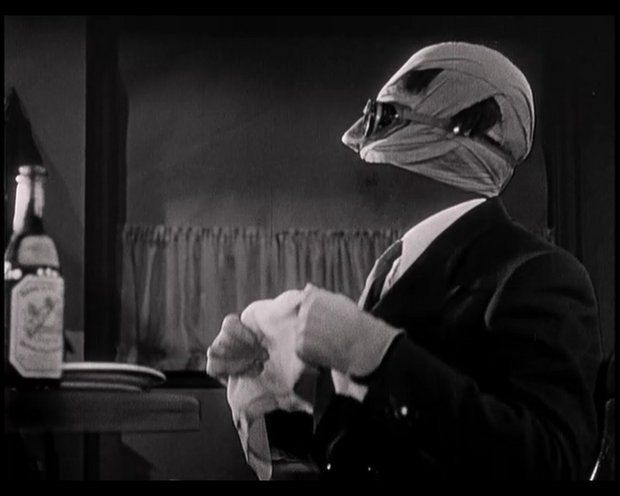The Invisible Man
1933
Who made it: Directed by James Whale. With Claude Rains, Gloria Stuart, Henry Travers.
Once upon a time: On a snowy night, a mysterious man wrapped in bandages comes to stay at a tiny inn, carrying a bag of chemicals. Is he an accident victim? A fugitive anarchist? The villagers can’t wait to see what’s under the gauze – until the man furiously rips it off to reveal… nothing. And then, unseen but not unfelt, begins a rampage of robbery, riot and murder.
Why kids will like it: Like all great what-if stories, this one not only begins with a terrific question, but then builds on it logically, to bring in not only the advantages of invisibility but the drawbacks. (Nudity is essential, which makes travelling during the winter difficult; food is visible until it’s digested.) And Griffin, our transparent antihero, isn’t only amazing but prankishly amusing — until the side-effects of megalomania and paranoia begin to take hold.
Why adults will like it: The movie was made more than 80 years ago, and yet the special effects — mostly painstaking multiple exposures, along with wires and special props — still delight. Even better? The sharp sense of humor (courtesy of director James Whale, who’d refine it even further in “The Bride of Frankenstein”) and the beautiful performance by a young Claude Rains — who, with only that marvelous vocal instrument of his to work with, constructed a complete, comic, romantic and eventually terrifying character.
Fast forward/freeze frame: This is one from the good old days, when a horror movie zipped by in 71 minutes (although a few kids may need help with the working-class English accents).
Fun trivia: Yes, that’s Clarence from “It’s a Wonderful Life,” Henry Travers, as Rains’ mentor — but even better, Rains’ love, Flora, is played by Gloria Stuart, who’d already done “The Old Dark House” for Whale, and oh, about 60 years later, would play the aged Rose in “Titanic.” (Also, horror fans, keep a very sharp eye out and you’ll spot Dwight Frye as a reporter and John Carradine as one of the villagers — as well as, at the end, the film’s most famous flub, when a supposedly barefoot invisible man nonetheless leaves shoeprints in the snow.)
Teachable moments: He’d undoubtedly preferred to have been remembered for his social activism and “serious” novels, but this book — like many of H.G. Wells’ other “scientific romances” — is still a fun, fast read for older children.
Double features: None of the various, B-movie sequels lived up to the promise of this original, although the theme of men driven mad by meddling “in things man must leave alone” is a popular one, in flicks from “Donovan’s Brain” to “The Invisible Ray” to any number of classic “Star Trek” episodes — and, of course, an entire lab filled with Dr. Jekylls. Seek them out, if you dare.

